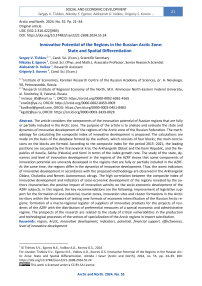Innovative Potential of the Regions in the Russian Arctic Zone: State and Spatial Differentiation
Автор: Tishkov S.V., Egorov N.E., Volkov A.D., Kovrov G.S.
Журнал: Arctic and North @arctic-and-north
Рубрика: Social and economic development
Статья в выпуске: 55, 2024 года.
Бесплатный доступ
The article considers the components of the innovation potential of Russian regions that are fully or partially included in the Arctic zone. The purpose of the article is to analyze and evaluate the state and dynamics of innovative development of the regions of the Arctic zone of the Russian Federation. The methodology for calculating the composite index of innovative development is proposed. The calculations are made on the basis of the database formed by the authors, which consists of four blocks; the main conclusions on the blocks are formed. According to the composite index for the period 2015-2021, the leading positions are occupied by the Krasnoyarsk Krai, the Arkhangelsk Oblast and the Komi Republic, and the Republics of Karelia, Sakha (Yakutia) and Komi in terms of the index growth rate. The study of the state, dynamics and level of innovation development in the regions of the AZRF shows that some components of innovation potential are unevenly developed in the regions that are fully or partially included in the AZRF. At the same time, the regions differ in the dynamics of innovative development. Thus, the worst indicators of innovative development in accordance with the proposed methodology are observed in the Arkhangelsk Oblast, Chukotka and Nenets Autonomous okrugs. The high correlation between the composite index of innovative development and indicators of socio-economic development of the regions revealed by the authors characterizes the positive impact of innovation activity on the socio-economic development of the AZRF subjects. In this regard, the key recommendations are the following: improvement of legislative support for the formation of eco-industrial, tourist zones, innovation sites and cluster formations in the Arctic territory within the framework of testing new formats of economic intensification of the Russian Arctic regions; formation of a macro-regional register of suppliers of innovative products for the projects of residents of the AZRF with the distribution of preferential measures of a special economic and administrative regime. The prospects of the research are related to the study of critical vulnerabilities in the production and technological processes of the sectors of specialization of the Arctic regions in import substitution.
Region, Arctic, innovative development, indicators, potential, financial support, effectiveness, level of innovative development
Короткий адрес: https://sciup.org/148329521
IDR: 148329521 | УДК: [332.1:316.422](985) | DOI: 10.37482/issn2221-2698.2024.55.24
Текст научной статьи Innovative Potential of the Regions in the Russian Arctic Zone: State and Spatial Differentiation
DOI:
The article was prepared with the financial support of the Russian Science Foundation grant No. 23-28-00693 “Formation and development of the innovation system of the Arctic zone of Russia in the context of the latest development contradictions: structural import substitution within a multi-level space”, URL:
The Arctic macro-region acts as a resource base for the development of many industries of the Russian economy. However, this role, as well as the development of the Arctic space in general, until recently relied heavily on international technological, technical, economic and scientific cooperation in the development of natural resources and minimizing the accompanying anthropogenic impact on fragile natural ecosystems [1, Skufina T.P.]. In many ways, the need for international cooperation was determined by the specifics of the Arctic — its harsh climatic conditions, increased costs and risks of conducting economic activities [2, Vasilyev V.V., Selin V.S.]. It should be noted that none of the circumpolar or interested countries currently has sufficient technological, technical, organizational and financial resources, as well as the legal framework for full-scale independent development of the Arctic spaces and the creation of appropriate infrastructure and icebreaker fleet [3, Gudev P .A.]. However, the extreme tightening of external sanctions pressure against Russia not only threatens the prospects for international economic and scientific cooperation in the macro-region, but also poses a serious challenge to the functioning of existing industries, including those critically important for the domestic economy [4, Skufina T.P., Baranov S.V., Samarina V.P.].
Thus, certain positive results in the field of economic development and job creation are shown by the implementation of a preferential regime for entrepreneurial activity in the Arctic, introduced by a number of regulations in 2020 [5, Volkov A.D., Tishkov S.V., Nikitina A.S.]. At the same time, taking into account the latest challenges, this preferential regime requires improvement in conjunction with other institutions for the development of Arctic territories in order to accelerate the development of innovative production in critical areas of import substitution. In the world practice of developing Arctic territories, there is successful experience in closing macroeconomic chains at the intraregional level, which has a positive effect on the qualitative and quantitative indicators of economic development of the territories [6, Kryukov Ya.V.]. For example, for the Arctic territories of the Republic of Karelia, the development of technologies and the deployment of the high-quality feed production used in aquaculture, as well as the provision of farms with genetic material is of utmost importance [7, Volkov A.D., Tishkov S.V.]. Currently, the most important condition for giving an innovative impetus to these areas is legislative support for the formation of eco-industrial and tourist zones in the Karelian Arctic - special economic zones of a new type with the prospect of spreading the experience of their creation throughout the entire territory of the Russian Arctic. For the Republic of Sakha (Yakutia), the development of small inno- vative businesses within the framework of high-tech industries is of crucial importance [8, Egorov N.E., Kovrov G.S.].
Modern science has considerable experience in studying the processes of development and management of northern and Arctic territories. The works of Russian and foreign authors propose methodological approaches to the study of the socio-economic development of regions, including the Arctic spaces. The problems of functioning of the northern territories of a number of foreign countries (Norway, Finland, Sweden, etc.) are dealt with by D. Depledge, K. Dodds [9], S. Glomsrod, G. Duhaime, I. Aslaksen [10], J. Jauhiainen, H. Moilanen [11], E. Purkarthofer, A. Humer [12], R.B. Jacobsen, A. E. Delaney [13].
There is currently an increased interest in the creation of regional innovation systems in the Arctic regions in Russia. Particular attention is paid to the conditions of their emergence, stages of development, institutions that contribute to the formation, as well as assessment of the results of their activities [14, Leksin V.N., Porfiryev B.N.; 15, Tishkov S.V.; 16, Zaikov K.S., Kalinina M.R., Kondratov N.A., etc.].
The challenges and limitations of innovative development of the Arctic regions of Russia were analyzed by A.V. Tsukerman [17; 18]. He presented a classification of challenges, including macroeconomic, raw materials, socio-demographic, financial, infrastructural, technological, legal, personnel, information, integration, transport challenges. All these challenges remain relevant during the period of formation of the special economic and legal regime of the Arctic zone of the Russian Federation; the mechanisms of their overcoming or levelling should be taken into account in the legal field and management practice.
In the work [19, Tyukavkin N.M., Anisimova V.Yu.], it is noted that the essence of import substitution should take into account both socio-economic and political factors, which will allow the state to develop steadily in the economic and production spheres. Measures to increase the competitiveness of products manufactured in the domestic market can be modernization of the technological base of an industrial enterprise, an increase in its efficiency indicators and an emphasis on the production of goods that can withstand healthy competition and have increased added value. When implementing an import substitution policy, it is necessary to improve the industrial complex of Russia and transition to an innovative type of economic development model. In the current conditions, it is extremely important for the Russian economy to maintain plans for the development of the Arctic without foreign partners. Therefore, it is necessary to pay special attention to the development of own production capacities, to create an “Arctic division” in terms of priority actions to ensure the development of the Russian economy in the conditions of external sanctions pressure, to combine the efforts of the state and business [20, Kotov A.V.].
Methods
In order to analyse and assess the current state, dynamics and level of innovative development of regions, the authors propose the following methodology (algorithm) for assessing the level of innovative development of regions on the basis of the study of existing methodological approaches and methods for assessing innovative development of regions [21, Tortsev A.M., Smirennikova E.V., Studenov I.I. et al.; 22, Ryapukhina V.N.; 23, Matvienko I.I.; 24, Egorov N.E., Kovrov G.S.; 25, Kuznetsova M.N., Vasilyeva A.S.; 26, Egorov N.E., Babkin A.V., Babkin I.A. et al.].
At the first stage, the database “ Scientific, educational and innovative-technological potential of Russian regions, fully or partially included in the Arctic zone, for the period 1995–2021 ” was formed, consisting of 4 blocks (22 indicators in total):
-
1. Block A. Main socio-economic indicators (SEP)
-
2. Block B. Scientific and innovative potential
A1 — Gross regional product, million rubles (before 1998 — billion rubles);
A2 — Population (at the end of the corresponding year), thousand people;
A3 — Average annual number of employees, thousand people;
A4 — Number of enterprises and organizations, units;
A5 — Fixed assets at the end of the year at full accounting value, million rubles (before 1997 — billion rubles);
A6 — Investments in fixed assets in actual prices, million rubles (before 1998 — billion rubles).
-
B1 — Organizations performing scientific research and development, units;
-
B2 — Level of innovative activity of organizations, %;
-
B3 — Number of personnel engaged in research and development, people;
-
B4 — Share of organizations carrying out technological innovations in the total number of surveyed organizations, %;
-
B5 — Number of students enrolled in bachelor’s, specialist’s, and master’s programs per 10,000 population (at the beginning of the school year), people;
-
B6 — Use of broadband Internet access in organizations in the total number of surveyed organizations, %;
-
B7 — Use of the Internet by the population in the total population, %.
-
3. Block C. Financial support for scientific and innovative activities
-
4. Block D. Result of innovation activity
C1 — Internal costs for research and development, million rubles;
C2 — Costs of innovation activities (until 2019 — technological innovations), million rubles;
C3 — Share of regional budget funds in internal research and development costs, %;
C4 — Costs of implementation and use of digital technologies, million rubles.
D1 — Volume of innovative goods, works and services, million rubles;
D2 — Inventive activity coefficient (number of applications filed for patents for inventions and utility models per 10,000 population);
D3 — Issue of patents for inventions and utility models, units;
D4 — Advanced production technologies used, units;
D5 — Ratio of exports to imports of technologies and technical services, thousand USD.
At the second stage, based on the values of the database indicators, calculations and a brief analysis are performed for blocks of regions of the Russian Arctic for the period from 2015 to 2021 and separately for 2021. For this purpose, the method of normalizing the values of each indicator and calculating the average normalized values of all indicators of the block by region of the Russian Arctic are used, based on the results of which the rating of the subjects of the Russian Arctic is carried out.
At the third stage, calculations of the “Composite index of innovative development of regions (CIIDR) of the Russian Arctic” are made as the arithmetic average of blocks (except for block A) according to the following formula:
CIIDR = (B*7/16 + C*4/16 + D*5/16)/3 (1)
where B, C, D are the average values of blocks multiplied by weighting coefficients (K block ), which are calculated as the ratio of the number of indicators in each block (N block ) to the total number of indicators of these blocks (N=16):
K block = N block /N (2)
Research results
Block A. Socio-economic potential
The analysis shows that, according to the average normalized value of 6 key indicators, the leading positions among the AZRF subjects for the period from 2015–2021 are occupied by the Krasnoyarsk Krai (1.0), the Yamalo-Nenets Autonomous Okrug (0.78) and the Republic of Sakha (Yakutia) (0.43) with an average value for the Russian Arctic of 0.38, and for 2021, the leaders’ ranking remains the same with the results almost unchanged, except for an increase in the average value for the Russian Arctic to 0.46. This comparison shows that the dynamics of the subjects’ SEP status over the period under review remains almost stable.
Based on the presented assessments, we can propose the following criteria for assessing the level of SEP (Table 1).
-
Table 1
Criteria for assessing the level of socio-economic indicators of the region 1
|
Criteria |
Characteristics of the SEP level |
|
0.67–1.00 |
High |
|
0.34–0.66 |
Average |
|
0.00–0.33 |
Low |
According to this table, the AZRF regions can be classified into the following types: regions with a high level of SEP (0.67–1.00) include the Krasnoyarsk Krai (1.0) and the Yamalo-Nenets
Autonomous Okrug (0.78). The average level (0.34–0.66) includes the Republic of Sakha (Yakutia) — 0.44. Other AZRF subjects have a low level (0.00–0.33).
Block B. Scientific and innovative potential
As the calculations show, the level of scientific and innovative potential of the AZRF subjects is comparable to the potential of the Russian Federation. An analysis of block B indicators shows that the top three in terms of scientific and innovative potential are headed by the Krasnoyarsk Krai (1.0), Yakutia (0.842) and the Murmansk Oblast (0.823). In accordance with the criterion for assessing the level of potential proposed above in the SEP assessment, the Komi Republic (0.764) and the Arkhangelsk Oblast (0.697) also have a high level of scientific and innovative potential (SIP) (from 0.67 to 1.00). The remaining 4 subjects have an average level (0.34–0.66): Chukotka Autonomous Okrug (0.649), Yamal-Nenets Autonomous Okrug (0.581), Karelia (0.576) and Nenets Autonomous Okrug (0.428) with an average value for the Russian Arctic (0.707). According to the 2021 rating, the positions of the four leaders did not change, with some variations in values: Krasnoyarsk Krai (1.0), Yakutia (0.974), Murmansk Oblast (0.810) and Komi Republic (0.776). The Republic of Karelia (0.714) and the Arkhangelsk Oblast (0.686) also showed a high level of NIP. The remaining 3 regions show an average level of NIP: Chukotka Autonomous Okrug (0.619), Yamal-Nenets Autonomous Okrug (0.535) and Nenets Autonomous Okrug (0.403). Thus, it can be stated that the subjects of the Russian Arctic have high and average levels of NIP.
One of the key indicators characterizing the scientific and innovative potential of the region is the “Level of innovative activity of organizations, %”, calculations of which for the period from 2015 to 2021 for the Russian Federation and the Russian Arctic, as well as for the AZRF subjects are presented below (Table 2).
-
Table 2
Level of innovation activity of organizations of the AZRF subjects for the period 2015-2021, % 2
|
Region |
2015 |
2016 |
2017 |
2018 |
2019 |
2020 |
2021 |
2021/2015 |
|
Russian Federation |
9.3 |
8.4 |
14.6 |
12.8 |
9.1 |
10.8 |
11.9 |
1.28 |
|
Murmansk Oblast |
9.4 |
7.2 |
16.2 |
11.6 |
9.6 |
9.4 |
10.0 |
1.06 |
|
Republic of Karelia |
7.2 |
6.4 |
5.9 |
9.2 |
7.1 |
7.0 |
6.4 |
0.89 |
|
Komi Republic |
5.2 |
4.5 |
8.8 |
10.6 |
7.2 |
8.0 |
8.9 |
1.71 |
|
Arkhangelsk Oblast |
5.9 |
4.7 |
4.4 |
7.5 |
4.2 |
4.7 |
4.6 |
0.78 |
|
Nenets Autonomous Okrug |
5.0 |
6.2 |
5.7 |
2.6 |
2.7 |
3.1 |
1.7 |
0.34 |
|
Yamalo-Nenets Autonomous Okrug |
7.4 |
9.0 |
7.0 |
8.6 |
5.4 |
5.9 |
6.8 |
0.92 |
|
Krasnoyarsk |
8.8 |
7.1 |
7.1 |
11.1 |
6.9 |
6.7 |
7.0 |
0.80 |
|
Republic of Sakha (Yakutia) |
7.0 |
7.6 |
7.9 |
8.6 |
3.9 |
8.6 |
14.5 |
2.07 |
|
Chukotka Autonomous Okrug |
17.8 |
7.2 |
10.7 |
12.5 |
7.8 |
6.7 |
9.0 |
0.51 |
|
AZRF |
8.19 |
6.66 |
8.20 |
9.15 |
6.09 |
6.67 |
7.65 |
0.93 |
The analysis of Table 2 shows that in the Russian Federation as a whole, a high level of innovative activity of organizations (IAO) was noted in 2017 (14.6%), and in the regions of the
Russian Arctic — in 2018 (9.15%). The analysis of the rate of change of IAO in 2021 compared to 2015 shows that the leaders are Yakutia (2.07 times), Komi (1.71 times) and Murmansk (1.06 times) with an average value for the Russian Federation of 1.28.
Block C. Financial support for scientific and innovative activities
Krasnoyarsk Krai takes the leading position among the regions that are fully or partially included in the AZRF in terms of financial support for research and innovation activities for the period from 2015 to 2021. Leading positions are also occupied by the Yamalo-Nenets Autonomous Okrug and Yakutia. However, it should be noted that in 2021 Yakutia ranked second, and Yamalo-Nenets Autonomous Okrug —third.
The differentiation of indicator values for blocks A, B and C considered above is presented in Fig. 1.
Block D. Result of innovation activity
The leading positions in terms of the results of innovative activity are occupied by the Krasnoyarsk Krai (1.0), the Murmansk Oblast (0.57) and the Yamalo-Nenets Autonomous Okrug (0.43).
The key indicator in this block is the indicator “Volume of innovative goods, works, services (IGWS), million rubles”, which ultimately characterizes the effectiveness of the subject’s innovative activities. As follows from the dynamics of IGWS, from 2018 to 2020, there has been a significant increase in the indicator by 2.88 times, with a subsequent decline in its value by 2021.
The assessment of the AZRF subjects by the average values of the IGWS indicator for the period 2015-2021 reflects the leadership of the Murmansk Oblast (1.0), Krasnoyarsk Krai (0.62) and Arkhangelsk Oblast (0.21). The remaining regions follow them with a large lag in the indicator values: the Republic of Karelia (0.09), the Komi Republic (0.03), in the Republic of Sakha (Yakutia) and the Yamal-Nenets Autonomous Okrug the indicator value is 0.02, and in the Chukotka Autonomous Okrug and the Nenets Autonomous Okrug — 0.00.
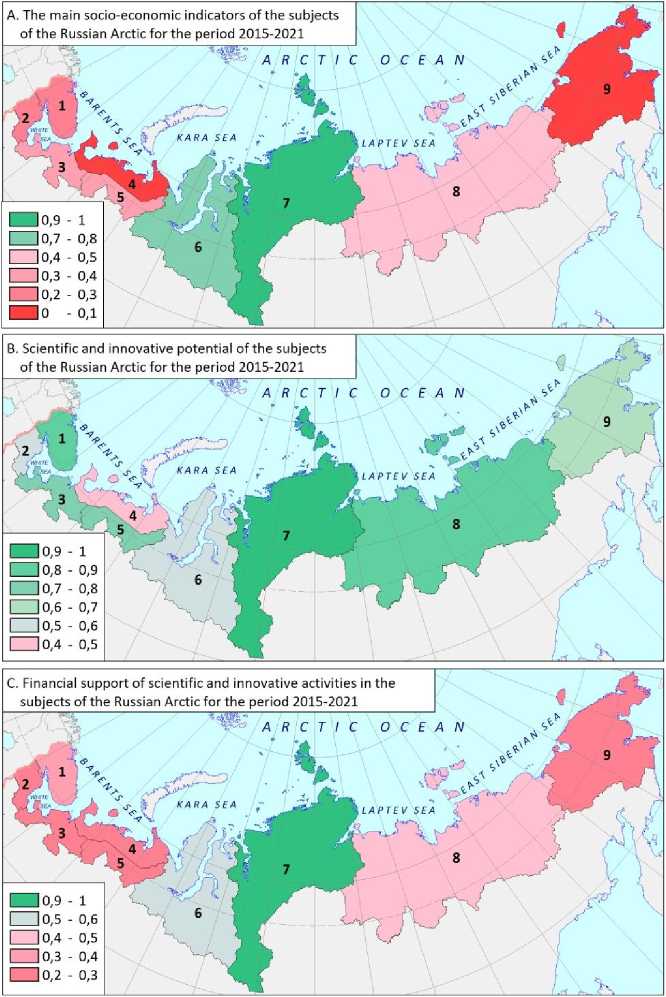
The numbers on the map indicate the territories of the subjects of the Russian Arctic:
1 - Murmansk Oblast, 2 - Republic of Karelia, 3 - Arkhangelsk Oblast, 4 - Nenets Autonomous Okrug,
5 - Komi Republic, 6 - Yamalo-Nenets Autonomous Okrug, 7 - Krasnoyarsk Krai,
8 - Republic of Sakha (Yakutia), 9 - Chukotka Autonomous Okrug
Fig. 1. Differentiation of indicators of innovation potential of the AZRF regions (blocks A, B, C)3
Discussion of results
In accordance with the proposed methodology, the calculation of the composite index of innovative development of regions (CIIDR) of the Russian Arctic and the Russian Federation was carried out on the basis of the values of 16 indicators from 3 blocks (except for block A) for the period from 2015 to 2021. (Table 3).
-
3 Source: compiled by Derusova O.V. on the basis of the authors’ calculations.
Table 3
Composite index of innovative development of regions (CIIDR) of the AZRF and the Russian Federation, 2015–2021 4
|
с о 'ад ас |
о |
Я |
я |
оо я |
я |
о я |
я |
ф го от Q |
ф га Е о: о 9 с |
ф 0х ГО LO -С О 2 см я |
|
Russian Federation |
0.276 |
0.268 |
0.285 |
0.292 |
0.290 |
0.312 |
0.331 |
0.293 |
0.989 |
19.8% |
|
Murmansk Oblast |
0.272 |
0.240 |
0.272 |
0.276 |
0.261 |
0.309 |
0.303 |
0.276 |
0.931 |
11.6% |
|
Republic of Karelia |
0.233 |
0.233 |
0.235 |
0.270 |
0.300 |
0.300 |
0.317 |
0.270 |
0.909 |
35.9% |
|
Komi Republic |
0.263 |
0.245 |
0.261 |
0.304 |
0.318 |
0.297 |
0.313 |
0.286 |
0.963 |
19.0% |
|
Arkhangelsk Oblast |
0.313 |
0.256 |
0.304 |
0.311 |
0.275 |
0.308 |
0.297 |
0.295 |
0.994 |
-4.9% |
|
Nenets Autonomous Okrug |
0.214 |
0.333 |
0.221 |
0.208 |
0.209 |
0.243 |
0.199 |
0.232 |
0.783 |
-6.9% |
|
Yamalo-Nenets Autonomous Okrug |
0.272 |
0.234 |
0.264 |
0.274 |
0.321 |
0.275 |
0.277 |
0.274 |
0.923 |
1.9% |
|
Krasnoyarsk |
0.289 |
0.274 |
0.271 |
0.304 |
0.315 |
0.310 |
0.314 |
0.297 |
1.000 |
8.8% |
|
Republic of Sakha (Yakutia) |
0.233 |
0.257 |
0.260 |
0.299 |
0.259 |
0.292 |
0.302 |
0.272 |
0.916 |
29.2% |
|
Chukotka Autonomous Okrug |
0.272 |
0.262 |
0.232 |
0.232 |
0.215 |
0.216 |
0.249 |
0.240 |
0.808 |
-8.7% |
|
AZRF |
0.262 |
0.259 |
0.258 |
0.275 |
0.275 |
0.283 |
0.286 |
0.271 |
0.914 |
8.9% |
The data in Table 3 show that the leading positions among the AZRF regions in terms of the composite CIIDR for the period 2015–2021 are occupied by the Krasnoyarsk Krai (1.00), the Arkhangelsk Oblast (0.99) and the Komi Republic (0.96), and the top three in terms of growth rates of the CIIDR in 2021 compared to 2015 are headed by the Republic of Karelia (35.9%), the Republic of Sakha (Yakutia) in the second place (29.2%) and the Republic of Komi in the third place (19.0%) with average growth rates for the Russian Arctic — 8.9%, and for the Russian Federation — 19.8%.
The comparative diagram of the average values of the CIIDR of the AZRF and the Russian Federation for the period 2015–2021 (Fig. 2) illustrates almost identical regression characteristics of variability for the period under consideration (R = 0.89).
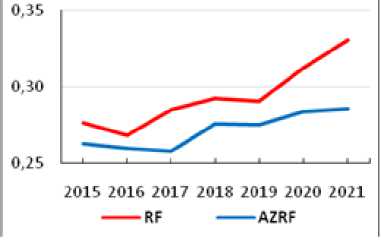
Fig. 2. Comparative diagram of the CIIDR of the AZRF and the Russian Federation for the period 2015–2021 5.
The considered indicators of block D, as well as the growth rate of the composite index of innovative development of regions are presented in Fig. 3.
-
4 Source: compiled by the authors.
-
5 Source: compiled by the authors.
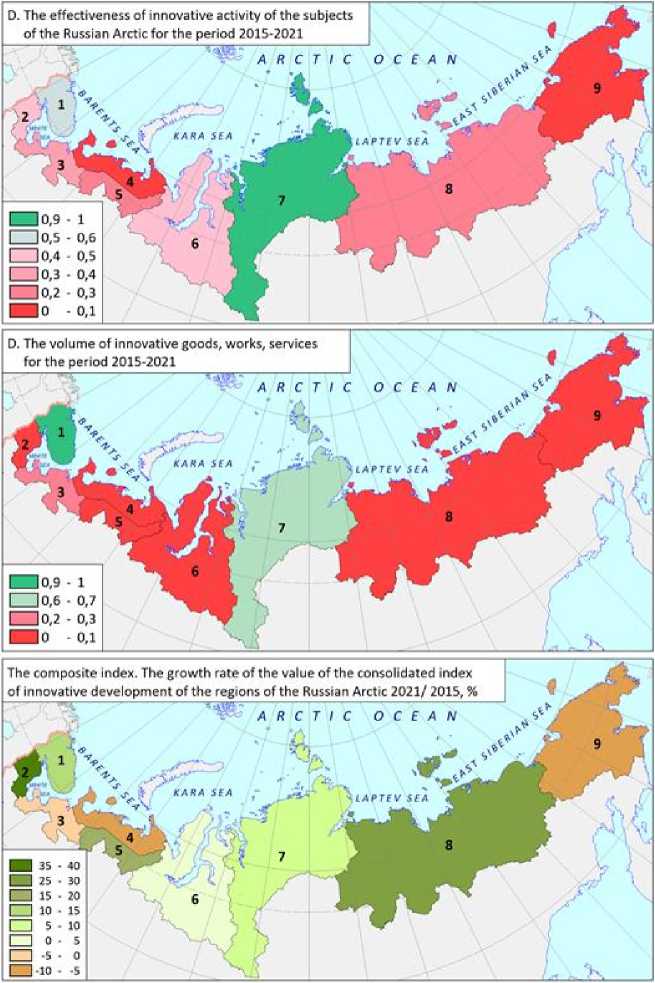
The numbers on the map indicate the territories of the subjects of the Russian Arctic:
1 - Murmansk Oblast. 2 - Republic of Karelia, 3 Arkhangelsk Oblast, 4 - Nenets Autonomous Okrug,
5 - Komi Republic, 6 - Yamalo-Nenets Autonomous Okrug, 7 * Krasnoyarsk Krai,
8 - Republic of Sakha (Yakutia), 9 • Chukotka Autonomous Okrug
Fig. 3. Differentiation of indicators of the innovative potential of the AZRF regions (block D and composite index) 6
Further, in order to assess the impact of innovation activity on socio-economic indicators of the AZRF subjects, the correlation between block A “Main socio-economic indicators” and the consolidated CIIDR for the Russian Arctic was calculated (Fig. 4).
-
6 Source: compiled by Derusova O.V. on the basis of the authors’ calculations .
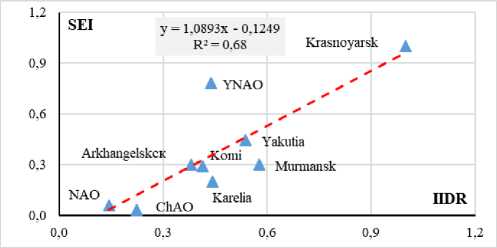
Fig. 4. Correlation between block A “Main socio-economic indicators” and the consolidated CIIDR for the AZRF for 2021 7.
Illustration of the correlation between block A “Main socio-economic indicators” and the consolidated CIIDR for the Russian Arctic for 2021 (Fig. 6) shows a high closeness of the relationship (R = 0.83), which characterizes the positive impact of innovation activity on socioeconomic development of the AZRF subjects.
An important criterion for assessing the effectiveness of innovation activities (IA) is the efficiency indicator, which in quantitative terms can be assessed through the coefficient of efficiency of IA (K eff ), calculated using the following formula [26, Egorov N.E., Babkin A.V., Babkin I.A., Martynushkin A.B.]:
K eff = Y/X (3)
where ̅ — average value of normalized input indicators characterizing the innovative potential of the region and assistance in the development of IA ;
Y — output parameter that determines the effectiveness of the IA.
In accordance with this methodology, the calculation of the coefficient of efficiency of innovation activity (K eff ) of the AZRF subjects for 2021 was carried out according to the data of blocks B, C (X) and block D (Y). Based on the results of calculations, a pie chart of distribution of normalized values of the coefficient of efficiency of IA of the AZRF subjects for 2021 was drawn up (Fig. 5).
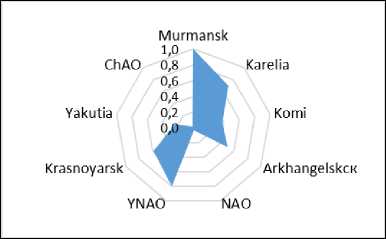
Fig. 5. Pie chart of the distribution of the efficiency coefficient of IA of the AZRF subjects for 2021 8.
The pie chart of the distribution of the efficiency coefficient of IA of the AZRF subjects for 2021 (Fig. 5) shows that the leaders in terms of the IA efficiency coefficient among the AZRF subjects are the Murmansk Oblast (1.00), the Yamalo-Nenets Autonomous Okrug (0.80) and the
-
7 Source: compiled by the authors.
-
8 Source: compiled by the authors.
Republic of Karelia (0.70).
Conclusion
The study of the state, dynamics and level of innovative development of the Russian Arctic regions shows that individual components of innovation potential are unevenly developed in the regions, fully or partially included in the AZRF. At the same time, the regions differ in the dynamics of innovative development. Thus, the worst indicators of innovative development in accordance with the proposed methodology are observed in the Chukotka and Nenets Autonomous okrugs. The high correlation between the composite index of innovative development and indicators of socio-economic development of the regions revealed by the authors characterizes the positive impact of innovation activity on the socio-economic development of the AZRF subjects.
In this regard, the key recommendations are:
-
• improvement of legislative support for the formation of eco-industrial, tourist zones, innovation sites and cluster structures in the Arctic territory within the framework of approbation of new formats of economic intensification of the regions of the Russian Arctic;
-
• formation of a macro-regional register of suppliers of innovative products for projects of residents of the Russian Arctic with the distribution of preferential measures of a special economic and administrative regime.
The prospects for the research are related to the study of critical vulnerabilities in the production and technological processes of the Arctic industries specializing in import substitution.
Список литературы Innovative Potential of the Regions in the Russian Arctic Zone: State and Spatial Differentiation
- Skufina T.P. Regional'noe razvitie Rossii v kontekste makroekonomicheskikh dvizheniy: monografiya [Regional Development of Russia in the Context of Macroeconomic Movements]. Apatity, IEP KSC RAN Publ., 2016, 126 p. (In Russ.)
- Vasiliev V.V., Selin V.S. Analysis of the Features of Production and Human Life in the Russian North. The North and the Market: Forming the Economic Order, 2017, no. 1 (52), pp. 17 25. EDN: YLEPAZ
- Gudev P.A. New Risks and Opportunities for Interstate Cooperation in the Arctic. Arktika i Sever [Arctic and North], 2019, no. 36, pp. 57 83. DOI: 10.17238/issn2221 2698.2019.36.57
- Skufina T.P., Baranov S.V., Samarina V.P. Analysis of Forecasting Documents for the Socio Economic Development of the Russian Arctic. Arktika i Sever [Arctic and North], 2022, no. 48, pp. 57 74. DOI: 10.37482/issn2221 2698.2022.48.57
- Volkov A.D., Tishkov S.V., Nikitina A.S. Evolution of Economic Management Mechanisms in the Russian Arctic: The Present Stage. “Ars Administrandi” (“The Art of Governance”), 2022, vol. 14, no. 2, pp. 174 201. DOI: https://doi.org/10.17072/2218 9173 2022 2 174 201
- Kryukov Y.V. The Role of Regional Suppliers in the Implementation of Arctic Projects: Russian Practice and Norwegian Experience. Arctic: Ecology and Economy, 2022, vol. 12, no. 3, pp. 430 443. DOI: https://doi.org/10.25283/2223 4594 2022 3 430 443
- Volkov A.D., Tishkov S.V. Strategic Development Priorities for the Karelian Arctic Region in the Context of the Russian Arctic Zone Economic Space Integration. Arktika i Sever [Arctic and North], 2022, no. 46, pp. 5 28. DOI: 10.37482/issn2221 2698.2022.46.5
- Egorov N.E., Kovrov G.S. Innovative Activity of Yakutia: Formation and Development. Vestnik of North Eastern Federal University. Series “Economics. Sociology. Culturology”, 2022, no. 2 (26), pp. 7
- DOI: https://doi.org/10.25587/SVFU.2022.45.15.001
- Depledge D., Dodds K. The UK and the Arctic. The RUSI Journal, 2011, vol. 156, iss. 3, pp. 72 79. DOI: https://doi.org/10.1080/03071847.2011.591097
- Glomsrod S. The Economy of the North. Statistisksentralbyrå, Oslo, Statistics Norway. Kongsvinger, 2015, 168 p.
- Jauhiainen J.S., Moilanen H. Towards Fluid Territories in European Spatial Development. Regional Development Zones in Finland. Environment and Planning C: Government and Policy, 2011, vol. 29 (4), pp. 728 744. DOI: https://doi.org/10.1068/c10162r
- Purkarthofer E., Humer A. City Regional Policies in the Planning Systems of Finland and Austria: Nationalinitiatives and European Opportunities. Belgeo, 2019, vol. 2, DOI: https://doi.org/10.4000/belgeo.32122
- Jacobsen R.B., Delaney A.E. When Social Sustainability Becomes Politics Perspectives from Greenlandic Fisheries Governance. Maritime Studies, 2014, vol. 13, art. 6. DOI: https://doi.org/10.1186/2212 9790 13 6
- Leksin V.N., Porfiryev B.N. Scientific and Institutional Capacity for Complex Development of the Russian Arctic Zone in the Medium and Long Term Perspectives. Studies on Russian Economic Development, 2015, no. 6, pp. 58 66.
- Tishkov S.V. The Directions of Regional Innovation Development of the Northern Border Region (Case Study of the Republic of Karelia). The North and the Market: Forming the Economic Order, 2017, no. 1 (52), pp. 121 128. EDN: YLEPEV
- Zaykov K.S., Kalinina M.R., Kondratov N.A., Tamitskii A.M. Innovation Course of Economic Development in the Northern and Arctic Territories in Russia and in the Nordic Countries. Economic and Social Changes: Facts, Trends, Forecast, 2017, vol. 10, no. 3, pp. 59 77. DOI: https://doi.org/10.15838/esc.2017.3.51.3
- Tsukerman V.A. Conceptual Foundations of Innovation Industrial Development in the North and in the Arctic. The North and the Market: Forming the Economic Order, 2012, no. 3 (31), pp. 146 150.
- Pilyasov A.N., Tsukerman V.A. Technological Modes, Innovations and Economic Development of the Russian Arctic. The North and the Market: Forming the Economic Order, 2022, vol.25, no. 4 (28), pp. 7 22. DOI: https://doi.org/10.37614/2220 802X.4.2022.78.001
- Tyukavkin N.M., Anisimova V.Yu. Import Substitution Processes in Russian Industry: Theoretical and Practical Aspects. MIR (Modernization. Innovation. Research), 2023, vol. 14, no. 1, pp. 43 57. DOI: https://doi.org/10.18184/2079 4665.2023.14.1.43 57
- Kotov A.V. Prospects for the Development of the Key Arctic Projects of the Russian Federation under the Conditions of Sanctions. Scientific and Analytical Herald of the Institute of Europe RAS, 2022, no. 5, pp. 113 123. DOI: https://doi.org/10.15211/vestnikieran52022113123
- Tortsev A.M., Smirennikova E.V., Studenov I.I., Novoselov A.P. Theoretical and Methodological Aspects of Evaluation of Innovative Development of the Arctic Regions of the Russian Federation. Russian Journal of Innovation Economics, 2018, vol. 8, no. 3, pp. 417 434. DOI: https://doi.org/10.18334/vinec.8.3.39386
- Ryapukhina V.N. Assessment of the Effectiveness of Innovative Development of Regions: Methodology and Rating. Russian Journal of Innovation Economics, 2018, vol. 8, no. 3, pp. 391 404. DOI: https://doi.org/10.18334/vinec.8.3.39300
- Matvienko I.I. Analysis of Innovative Development of the Arctic Zone Regions in the Russian Federation. Russian Journal of Innovation Economics, 2020, vol. 10, no. 1, pp. 307 324. DOI: https://doi.org/10.18334/vinec.10.1.100663
- Egorov N.E., Kovrov G.S. Comparative Assessment of Innovative Development of the Far North Regions. Arktika i Sever [Arctic and North], 2020, no. 41, pp. 62 74. DOI: 10.37482/issn2221
- 2698.2020.41.62
- Kuznetsova M.N., Vasilyeva A.S. Innovation Potential of Regions within the Arctic Zone of the Russian Federation: Assessment Methodology, Comparative Analysis, Development Prospects. Economic and Social Changes: Facts, Trends, Forecast, 2023, vol. 16, no. 2, pp. 69 87. DOI: https://doi.org/10.15838/esc.2023.2.86.4
- Egorov N.E., Babkin A.V., Babkin I.A., Martynushkin A.B. Assessment of Sustainability and Effectiveness of Innovative Development of Economic Agents of the Russian Arctic. The North and the Market: Forming the Economic Order, 2022, no. 2 (76), pp. 35 44. DOI: https://doi.org/10.37614/2220 802X.2.2022.76.003

